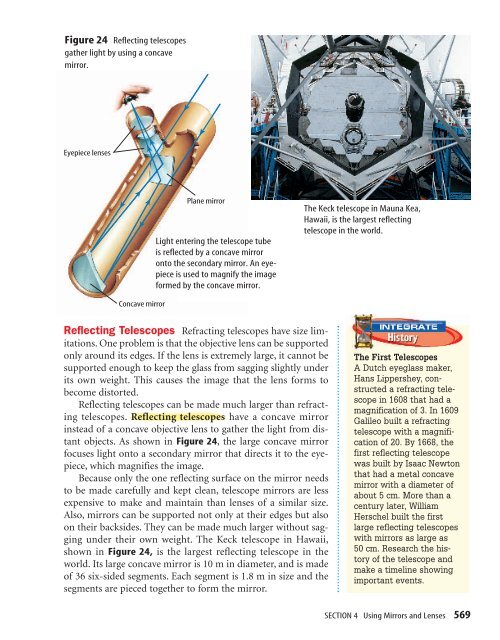Light Mirrors and Lenses (3379.0K) - McGraw-Hill Higher Education
Light Mirrors and Lenses (3379.0K) - McGraw-Hill Higher Education
Light Mirrors and Lenses (3379.0K) - McGraw-Hill Higher Education
- No tags were found...
You also want an ePaper? Increase the reach of your titles
YUMPU automatically turns print PDFs into web optimized ePapers that Google loves.
Figure 24 Reflecting telescopesgather light by using a concavemirror.Eyepiece lensesPlane mirror<strong>Light</strong> entering the telescope tubeis reflected by a concave mirroronto the secondary mirror. An eyepieceis used to magnify the imageformed by the concave mirror.The Keck telescope in Mauna Kea,Hawaii, is the largest reflectingtelescope in the world.Concave mirrorReflecting Telescopes Refracting telescopes have size limitations.One problem is that the objective lens can be supportedonly around its edges. If the lens is extremely large, it cannot besupported enough to keep the glass from sagging slightly underits own weight. This causes the image that the lens forms tobecome distorted.Reflecting telescopes can be made much larger than refractingtelescopes. Reflecting telescopes have a concave mirrorinstead of a concave objective lens to gather the light from distantobjects. As shown in Figure 24, the large concave mirrorfocuses light onto a secondary mirror that directs it to the eyepiece,which magnifies the image.Because only the one reflecting surface on the mirror needsto be made carefully <strong>and</strong> kept clean, telescope mirrors are lessexpensive to make <strong>and</strong> maintain than lenses of a similar size.Also, mirrors can be supported not only at their edges but alsoon their backsides. They can be made much larger without saggingunder their own weight. The Keck telescope in Hawaii,shown in Figure 24, is the largest reflecting telescope in theworld. Its large concave mirror is 10 m in diameter, <strong>and</strong> is madeof 36 six-sided segments. Each segment is 1.8 m in size <strong>and</strong> thesegments are pieced together to form the mirror.The First TelescopesA Dutch eyeglass maker,Hans Lippershey, constructeda refracting telescopein 1608 that had amagnification of 3. In 1609Galileo built a refractingtelescope with a magnificationof 20. By 1668, thefirst reflecting telescopewas built by Isaac Newtonthat had a metal concavemirror with a diameter ofabout 5 cm. More than acentury later, WilliamHerschel built the firstlarge reflecting telescopeswith mirrors as large as50 cm. Research the historyof the telescope <strong>and</strong>make a timeline showingimportant events.SECTION 4 Using <strong>Mirrors</strong> <strong>and</strong> <strong>Lenses</strong> 569

















